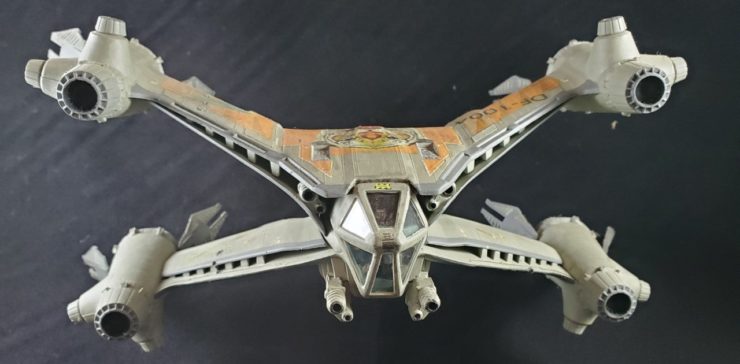Science fiction and fantasy fans love to dream about things that never existed. And some of them enjoy bringing objects and ideas from their imagination to life. Whether working from kits or making something from scratch, there is a great deal of enjoyment to be gained from model building, and satisfaction in seeing a finished project. This is a great time for those who enjoy the hobby: the internet has provided ways to share information with other modelers and to shop for kits and products from around the world, and the new technology of 3D printing has opened up even more ways to bring imaginary things to life. So if, like a lot of people these days, you have some extra time on your hands, you might want to look into model building
We live in a time where social distancing has become imperative. Folks are being warned to minimize contact with other people, keep a safe distance and remain in their homes as much as possible. This has become a source of good-natured humor in the model-building community, whose members spend a lot of time at benches tucked away in a basement or corner of their house. “We’ve been training for this our whole lives,” they joke. But this also raises a good point: Modeling is a perfect hobby for these times. The topic of model building hasn’t been specifically addressed before on Tor.com, other than this column on reproducing movie props, and this column on building miniatures in general. So for those who might be interested, here’s some information on a perfect hobby for the social distancing era, and some advice on how to get started.
Model Building in the Old Days
I got into model building back in the late 1960s, at about the age of 11 or 12. I had a lot of toy soldiers, and Airfix sold boxes of 50 little one-inch-tall soldiers for 50 cents. Then I found out that Airfix sold airplane models in the same scale. I bought many kits, along with glue and enamel paints, and got busy. My brothers and I had a wire running diagonally across our room up near the ceiling, and had quite a squadron on display…until one night, the Great Broken Wire Disaster destroyed them all, except for one helicopter that apparently auto-rotated to safety, and a P-47 too sturdy to destroy. Monogram came out with a series of American troops and vehicles, and I built and painted pretty much all of them. The next year I discovered Tamiya models, and a whole series of World War II forces from a variety of nations. I started assembling model railroad rolling stock, and people and buildings to go with them. There were also a few spaceships built along the way, but they were harder to find. My departure for college ended that phase of my model-building career.
Throughout the 1980s and 1990s, I built models on and off again. There were a whole lot of wargaming miniatures that caught my attention, many with science fiction themes—it was easy and cheap for companies to produce them using lead-based pewter and a technique called lost-wax casting. I didn’t play the games, but the figures were fun to paint. I eventually found more science fiction-themed kits to build, including spaceships, and robot models from Japan. Because buying models is easier than building them, like many people, I soon began to build up a stash of kits. I built a model of the Millennium Falcon, one of the first kits I weathered to make it look like the “hunk of junk” portrayed in the movie. And after I discovered the show Babylon 5, I built a model of the station and a whole fleet of miniatures from all the various alien races. One of the last models I built during that phase of my career was a Babylon 5 Starfury, weathered and detailed in Captain Sheridan’s livery (pictured at the top of the article). And then 9/11 came along, my life got busy, and I put models aside for over a decade.
Model Building Today
A few years ago, I decided to pull out my old kits and get started again. I found that the world of model building had changed. The enamel paints I had always used were being supplanted by acrylic paints, which are easier to use, less smelly, and far easier to clean up. Lead, long an ingredient of paint and pewter miniatures, had disappeared. There were a lot more models available, with old ones being re-released, and a wide variety of new ones on the market. Small-scale producers of vinyl and resin models have long been around, but now there are producers of 3D printed models, and some hobbyists are even manufacturing models with their own printers. The Internet is a great resource, with all sorts of models and supplies being offered for sale, websites providing tips, YouTube videos providing advice, and chat groups and Facebook groups widely accessible. I would say we are in a Golden Age of model building, with only one caveat—the hobby has become very expensive (lots of gold required, I suppose).
With all the new things I was discovering, even though I already had many models on hand, I couldn’t resist buying more. I finished some Scopedog robots I started years ago, and began experimenting with diorama ideas:
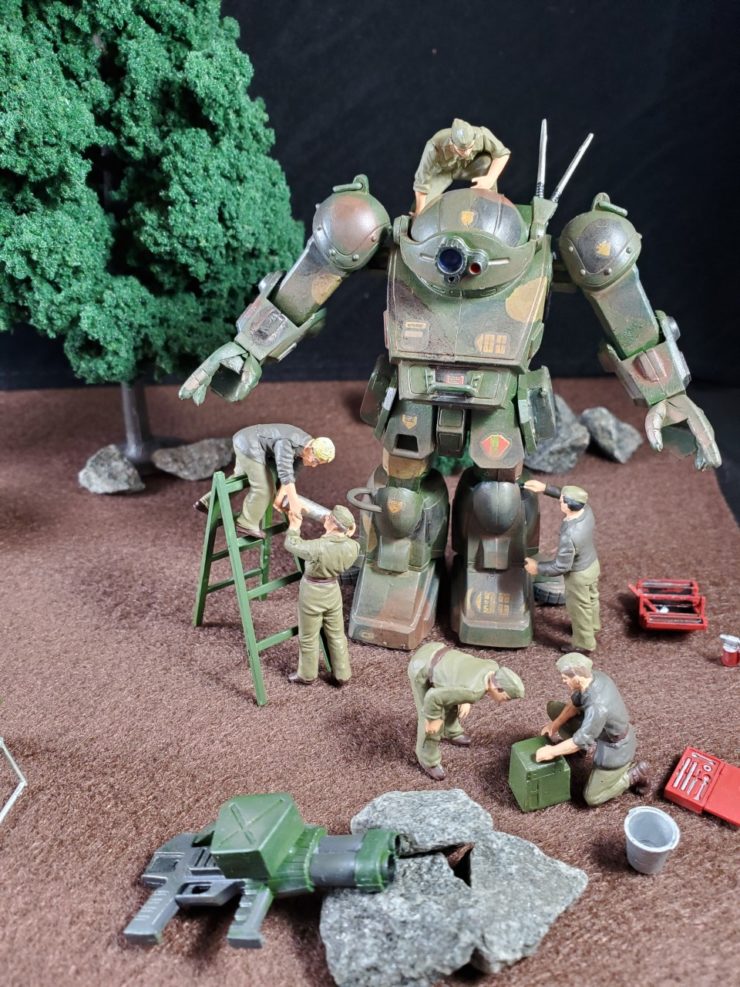
I also found some fun little Bandai kits based on the Dragon Ball anime series. These are quick and easy to snap together (or glue together if you desire), come pre-molded in multiple colors, and have stickers instead of decals. The only thing you have to do is paint the figures, and a few details on the vehicles. Based on my enjoyment of these kits, I bought some Bandai Star Wars kits, and also some Gundam fighting robot kits. Here’s the Dragon Ball kits I’ve completed so far:
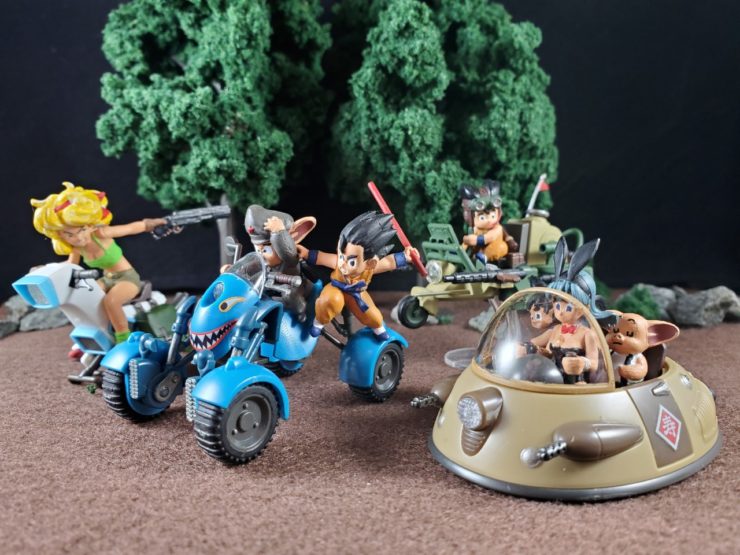
And here’s a picture of some of my current stash of kits, with a few boxes from recent and current builds thrown in. You can see the diversity: old kits, some re-releases of old favorites, and new ones as well:
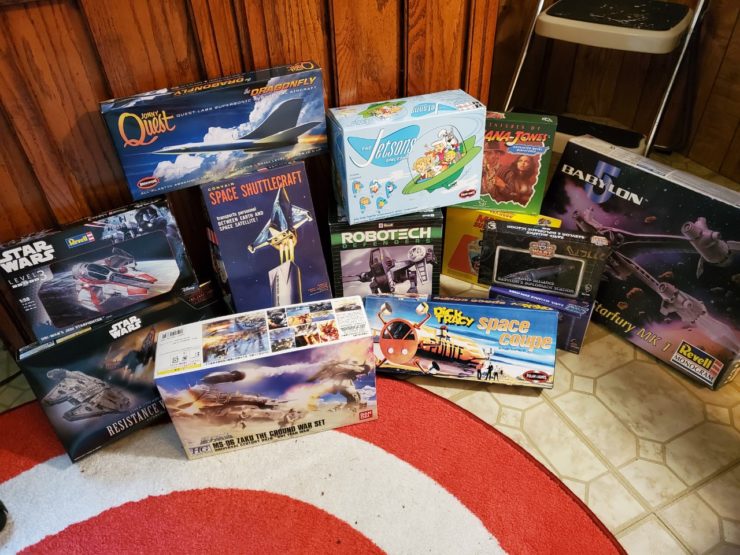
Gaming Miniatures and Military Models
One of the most popular types of science fiction and fantasy-related modeling is building miniatures for tabletop gaming. You’ll encounter a variety of scales in this sort of project—scales are either expressed in terms of the ratio between actual and model size, or based on the height in millimeters of a model of a typical person. Here is a comparison:
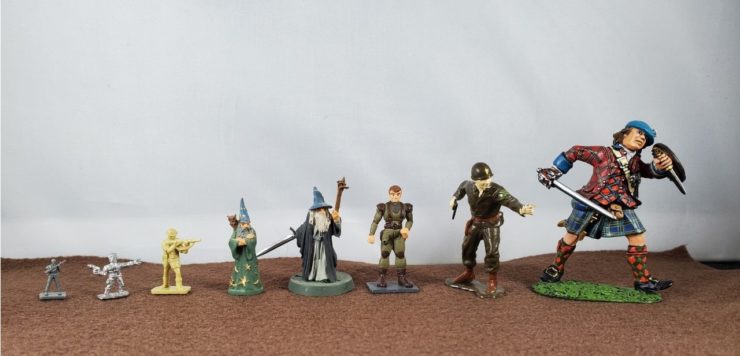
Starting on the left is a 1/144 trooper from a Gundam robot set. In that scale, one inch of height in a model depicts 144 inches (or 12 feet) in the real world, so the little guy is about a half inch high. The second figure is a pewter science fiction figure, I think intended for Traveller games. He is in 15mm scale, which works out to about 1/100. The next is an Airfix figure from the British Eighth Army, 1/72 scale, or about an inch tall (the guys I bought whole brigades of when I was young). The next is a wizard in the standard size used in many role-playing games, 25mm (about 1:56). The Gandalf next to him is a more modern figure in 28mm scale. In recent years, gaming miniatures have become a little beefier than they formerly were, and are generally mounted on a standardized plastic disc base. The next figure is a pilot for a Scopedog robot in 1/48 scale, about 1.5 inches tall. And after him is a 1/35 scale American Army lieutenant from the early 1960s—one of the first figures I ever painted (I don’t know why this particular scale is the most common for army figures, when 1/36 would make it an even three feet to the inch, and 1/32, would make them compatible with the most common scale for military aircraft). And finally, you have a professionally painted miniature of a Scots warrior from the Battle of Culloden, in 54mm scale (just slightly larger than 1/32). This is the largest scale generally used in war games, with figures of this size being popular with collectors.
The most popular tabletop gaming systems these days seem to be the perennial Dungeons & Dragons and Warhammer 40,000, although a wide range of others are available. There are many miniatures available, not just in the traditional pewter but also in injection molded plastics. And there is an increasing number of companies making terrain features and buildings for these games. My son, who has been playing D&D with the same circle of friends for over 20 years, has recently been having fun with modular dungeon sets and building kits from a company called Dwarven Forge. The game environments he creates sure beat the heck out of the old graph paper on top of the table:
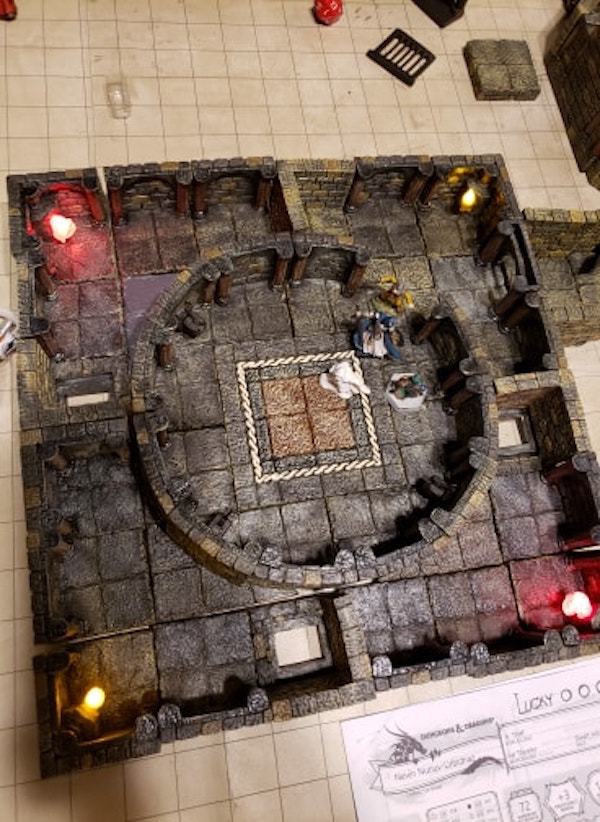
There are also a lot of war games involving spaceships. Star Wars games are popular these days, and include Star Wars: X-Wing, which looks at fighter and small ship combat, and Star Wars: Armada (I was never interested in these because the miniatures are already pre-built and pre-painted). When I was watching the Babylon 5 TV show, I had a lot of fun painting ships from Agents of Gaming even though I never played the games:
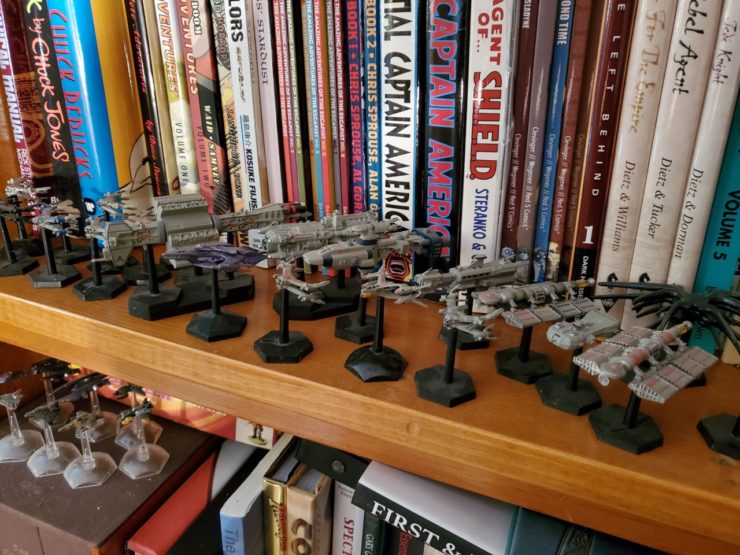
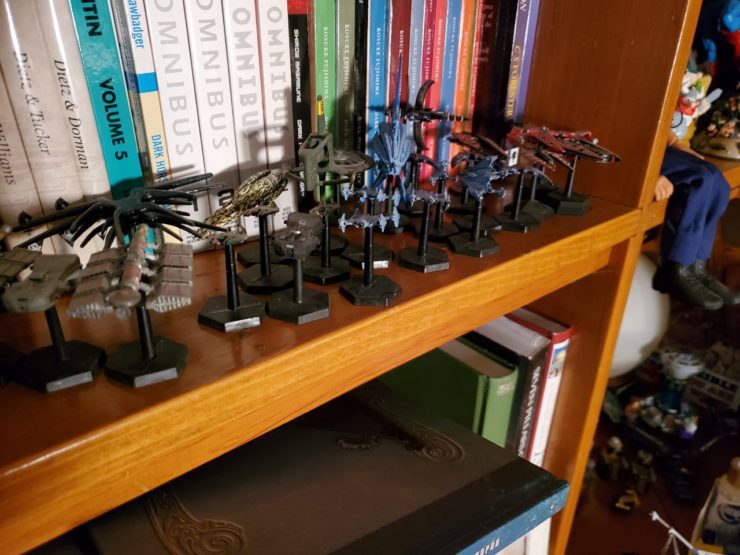
One other key type of military science fiction model, not associated with wargaming, is the Gundam robot. These are based on popular Japanese anime shows, and are giant fighting robots. Available from Bandai models, they are generally molded in all the colors appropriate to the finished product, feature snap-together construction, and come with stickers included, so they are easy projects for the beginner. The advanced modeler can also invest plenty of effort in detailing them. They are highly posable, fun to display, and available in 1/144, 1/100 and 1/60 scales. Here is my first Gundam model, just snapped together, and not yet finished (in 1/144 scale, with the tiniest little soldier from the picture above provided for scale):
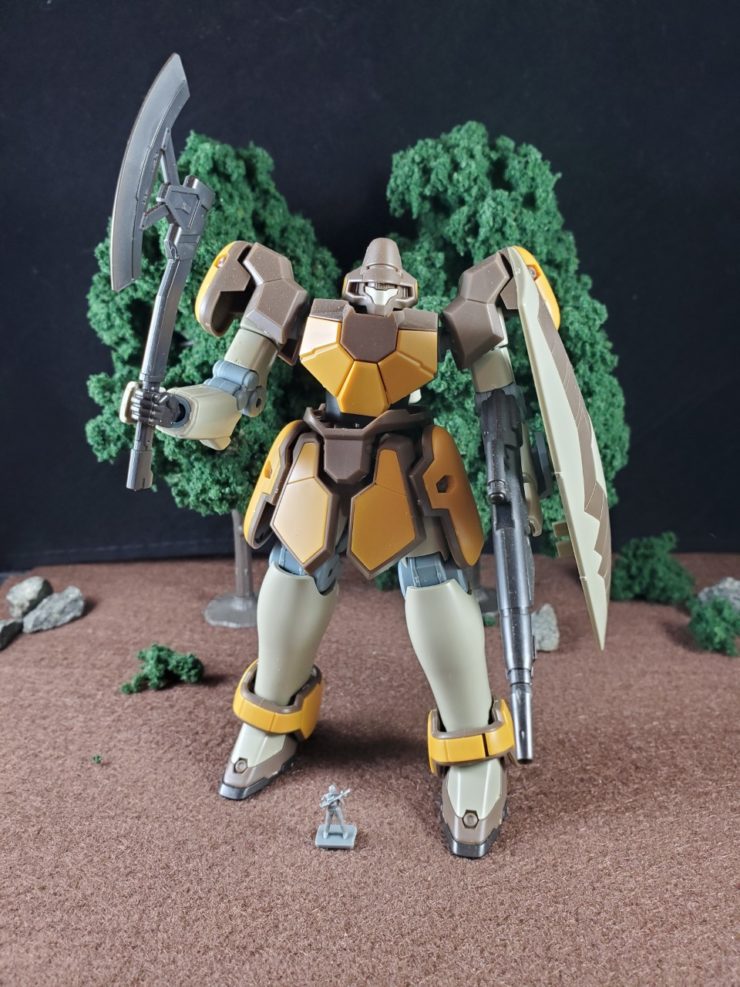
Spaceship Modeling: Greebles and Azteking
The first big difference between figure modeling and spaceship modeling is the scale: Space fighters, such as Star Wars Ties and X-Wings, and the Babylon 5 Starfury, are about the size of a WWII fighter plane, so their scales overlap with those you find with figures (the Starfury above is in 1/72 scale, with a one-inch pilot and a wingspan of 10 inches). But when you look at freighters and capital ships, the appropriate scales change accordingly. A 1/72 scale Millennium Falcon is about eighteen inches long and a dozen inches wide, getting a bit large to display on a shelf, or even hang from your ceiling, like this one:
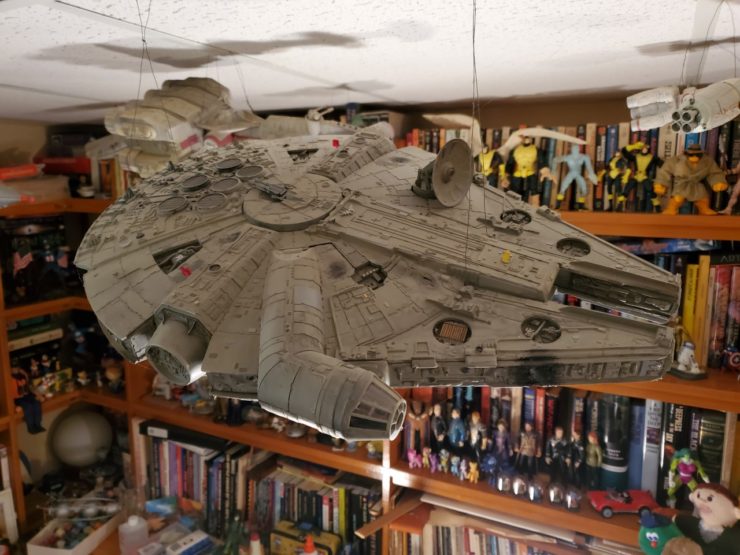
The model of the Babylon 5 space station, seen below next to my 1/72 scale Starfury model, is about 18 inches long. Since the opening narration of the episodes says the station is five miles long, if my calculations are correct, that makes the scale about 1/17600, a pretty impressive number:
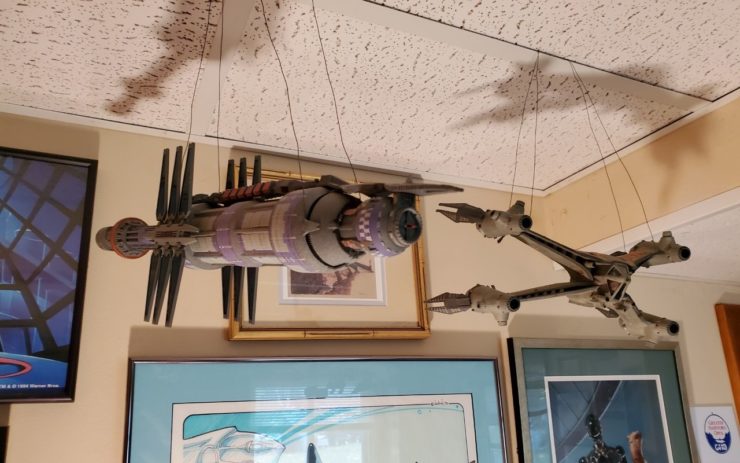
So, the bigger the ship, the smaller the scale. While a 1/72 Falcon is big, a 1/350 scale Falcon will fit in the palm of your hand. Imperial Star Destroyers can be bought in the scale of 1/2700, 1/5000 or even 1/14500. The Blockade Runner Princess Leia used in the original Star Wars is available in 1/1000. Star Trek capital ships, like the Enterprise, while smaller than Star Destroyers, are still pretty large, and can be found in 1/350, 1/500, 1/1000, and even in smaller size models with a scale of 1/2500.
One thing I enjoy seeing is the re-release of old models, such as those available from the Polar Lights company. I have seen many of the ships conceptualized by Werner von Braun and Willy Ley available again in local hobby stores, ships like this lunar orbiter from one of the old Disney science shows (I apologize for the quality of the build, which leaves a lot to be desired—it was built decades ago):
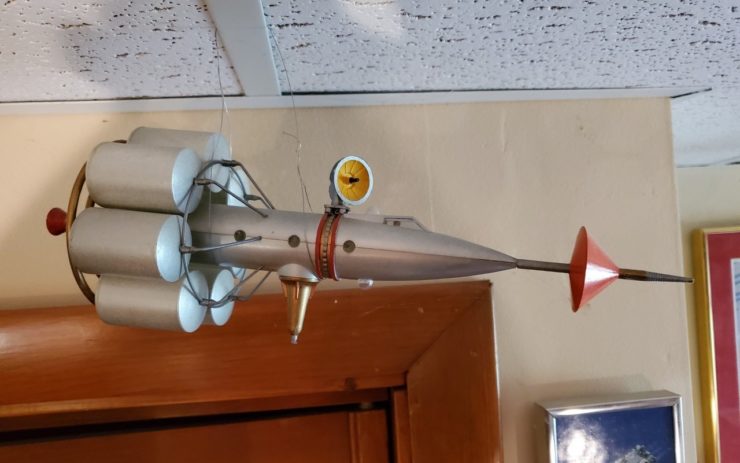
One of the fun aspects of modeling is not just assembling your kit painted in basic colors, but taking the further step of making it look real and lived in. For me, a transition from military models to Star Wars models was quite easy, because the aesthetic of Star Wars is a battered, weathered and lived-in look. The ships are covered with all sorts of interesting piping and gadgets, each of which gives you an opportunity to make things interesting. All those details have come to be called “greebles,” and if you look at close-ups of the old Star Wars filming models, you see all sorts of things from old model kits glued to the surface to create an industrial effect. Streaks of mud, dark lines between mismatched panels, chipped paint, running rust, battle damage, scorching from re-entries; all of it contributes to the beat-up look model builders love to replicate.
And while folks think of Star Trek ships as being sleeker and cleaner looking, there are still a lot of details that make building those ships fun. While the original TV version of the USS Enterprise looked bright and pristine, starting with Star Trek: The Motion Picture, more interesting features were added. The most distinctive of these involved differences between the color of panels, which modelers recreate through a process called “Azteking.” This is done either by paint, or by large sheets of decals, which can be quite difficult to place. There are also other details that can be added, including open shuttle bays with shuttles inside. A lot of modelers like to outfit their kits with lighting, and the many portholes on Federation starships look great when drilled out and lighted.
What You Need to Get Started
The first thing you need is a place to work. When I was younger, living in an apartment, I had a big tray with all my tools and paint on it, which I set up on the coffee table, sitting cross-legged on the floor. Since model buying is easier than model building, you will also need storage space for your stash. And you will want a shelf to display your models—or for spaceships, wires hanging from the ceiling. Now that I own a home, I have a work bench in my den that works pretty well:
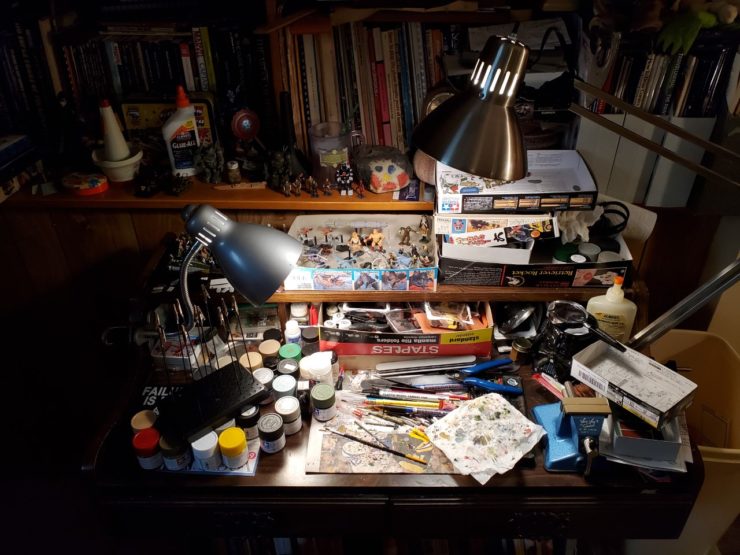
You’ll need some paints to get started. I find Tamiya acrylic paints, which are thinned with alcohol, to be a good, all-around paint. While a lot of modelers swear by their air brushes, they are very expensive and complex, so to start with, you should probably stick to pre-mixed spray cans (or rattle cans, as they are known because of the sound they make when shaken). Clear lacquers, like Testor’s Dullcote and Glosscote, are valuable in finishing your model. You will need glue, including styrene glue for plastic models, cyanoacrylate or super glue, and some white glue (which I use for windshields, because it doesn’t ruin them if you make a mistake). You will need a few tools, including a sharp hobby knife like an X-Acto knife, small files, emery boards, tweezers, and something called a sprue cutter (a pair of nippers that removes parts off the sprue without leaving damage). Last year, I found a good starter kit of tools called a Gundam model tool kit on Amazon. One note of caution about purchasing modeling supplies from Amazon, though: while you can find a lot, and often at good prices, because so many come from third party vendors, prices can vary wildly (especially on discontinued items), and some come with pretty hefty shipping prices. One place where paying extra for shipping helps, however, is for models from Japan, where surface shipping can add months to your wait time. There are a number of good online hobby stores that cater to customers on the web.
The Internet is the modeler’s best friend. There are scads of YouTube videos offering advice, unboxing videos that show exactly what you will find when you open a particular kit, and all sorts of discussion groups and Facebook groups. One of my favorite Facebook groups on science fiction model building is this one, Starship Modeler, a science fiction-oriented group that is so focused on providing support that members can be ejected for making negative comments when someone posts a picture of a recently completed model. As someone with modest skills, I also like The Mediocre Modelers Club, which features all sorts of models, emphasizes the fun of the hobby, and pokes a bit of fun at folks who take details too seriously. One word of caution when it comes to Internet advice: There are as many approaches to the hobby as there are modelers, and most of them are convinced that their approach is the only correct one.
Final Thoughts
So, that’s my personal experience with science fiction model building, and some advice how you can get started on your own. As an added bonus, here’s a link to a paper model of Tor.com’s own Stubby the Rocket from a few years back. All you need is some heavy paper to print your own spaceship!
Now it’s your turn to talk: I’m interested in hearing about other people’s experience with science fiction model building, because I know this article just scratches the surface. And if you’ve got any questions, I’ll do my best to answer them in the comments below.
Alan Brown has been a science fiction fan for over five decades, especially fiction that deals with science, military matters, exploration and adventure.










